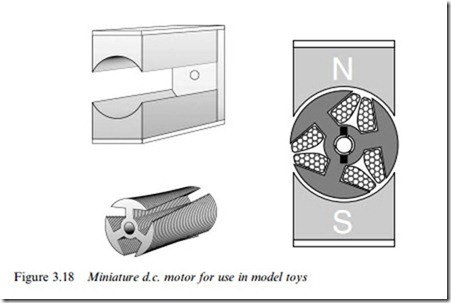TOY MOTORS
The motors used in model cars, trains etc. are rather diVerent in construction from those discussed so far, primarily because they are designed to be cheap to make. They also run at high speeds, so it is not important for the torque to be smooth. A typical arrangement used for rotor diameters from 1 cm to perhaps 3 cm is shown in Figure 3.18.
The rotor, made from laminations with a small number (typically three or Wve) of multi-turn coils in very large ‘slots,’ is simple to manu- facture, and because the commutator has few segments, it too is cheap to make. The Weld system (stator) consists of radially magnetised ceramic magnets with a steel backplate to complete the magnetic circuit.
The rotor clearly has very pronounced saliency, with three very large projections which are in marked contrast to the rotors we looked at earlier where the surface was basically cylindrical. It is easy to imagine that even when there is no current in the rotor coils, there is a strong tendency for the stator magnets to pull one or other of the rotor saliencies into alignment with a stator pole, so that the rotor would tend to lock in any one of six positions. This cyclic ‘detent’ torque is due to the variation of reluctance with rotor position, an eVect which is exploited in a.c. reluctance motors (see Chapter 9), but is unwanted here. To combat the problem the rotor laminations are skewed before the coils are Wtted, as shown in the lower sketch on the left.
Each of the three rotor poles carries a multi-turn coil, the start of which is connected to a commutator segment, as shown in the cross section on the right of Figure 3.18. The three ends are joined together. The brushes are wider than the inter-segment space, so in some rotor positions the current from say the positive brush will divide and flow Wrst through two coils in parallel until it reaches the common point, then
through the third coil to the negative brush, while in other positions the current flows through only two coils.
A real stretch of imagination is required to picture the mechanism of torque production using the ‘BIl ’ approach we have followed previ- ously, as the geometry is so diVerent. But we can take a more intuitive approach by considering, for each position, the polarity and strength of the magnetisation of each of the three rotor poles, which depend of course on the direction and magnitude of the respective currents. Following the discussion in the previous paragraph, we can see that in some positions there will be say a strong N and two relatively weak S poles, while at others there will be one strong N pole, one strong S pole, and one unexcited pole.
Thus although the rotor appears to be a 3-pole device, the magnetisation pattern is always 2-pole (because two adjacent weak S poles function as a single stronger S pole). When the rotor is rotating, the stator N pole will attract the nearest rotor S pole, pulling it round towards alignment. As the force of attraction diminishes to zero, the commutator reverses the rotor current in that pole so that it now becomes a N pole and is pushed away towards the S stator pole.
There is a variation of current with angular position as a result of the diVerent resistances seen by the brushes as they alternately make contact with either one or two segments, and the torque is far from uniform, but operating speeds are typically several thousand rev/min and the torque pulsations are smoothed out by the rotor and load inertia.
